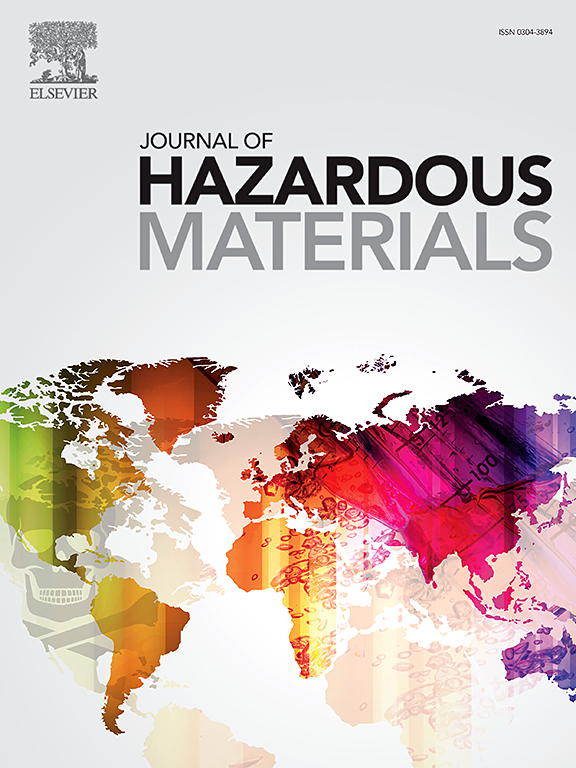An integrated carbon dots-based sensing platform via alkali-assisted hydrothermal reaction for pH/Fe(II) detection and a sensing array for sulfur species
IF 11.3
1区 环境科学与生态学
Q1 ENGINEERING, ENVIRONMENTAL
引用次数: 0
Abstract
In this study, the nitrogen-doped carbon dots (NCDs) were synthesized from phenolphthalein and m-phenylenediamine via a NaOH-mediated hydrothermal reaction. The blue-emitting NCDs functioned as dual-mode pH sensors, exhibiting a quenching effect in acidic solutions (pH=2–7) and colorimetric changes in alkaline environments (pH=8–12). Notably, the sensor exhibited stable performance up to five consecutive test cycles. The reliability of the method was verified through the pH analysis of commercial beverages. The highly stable NCDs exhibited a selective fluorescence quenching to Hg2+ through electron transfer and redox reactions, enabling the successful construction of an on-off-on sensor array (NCDs@Hg) for the selective analysis of sulfite, sulfide, and thiosulfate with high selectivity. The three sulfur compounds were successfully differentiated and analyzed via principal component analysis (principal component 1 with a variance of 95%). Notably, EDTA-modified NCDs exhibited enhanced selectivity towards Fe2+ through static quenching, enabling its detection over the concentration range of 2.25–45.00 μM, with a detection limit of 0.169 μM. The applicability of the sensor was validated in real samples, demonstrating satisfactory recovery rates. These findings demonstrate that NCDs are promising nanomaterials for multi-target detection through tunable sensing parameters, thereby enabling diverse practical applications.

基于碱辅助水热反应的集成碳点传感平台用于pH/Fe(II)检测和硫种传感阵列
在本研究中,以酚酞和间苯二胺为原料,通过naoh介导的水热反应合成了氮掺杂碳点(NCDs)。蓝色发光NCDs具有双模pH传感器的功能,在酸性溶液(pH= 2-7)中表现出猝灭效应,在碱性环境(pH= 8-12)中表现出比色变化。值得注意的是,该传感器在连续五个测试周期中表现出稳定的性能。通过对商品饮料的pH值分析,验证了该方法的可靠性。高度稳定的NCDs通过电子转移和氧化还原反应表现出对Hg2+的选择性荧光猝灭,从而成功构建了一个on-off-on传感器阵列(NCDs@Hg),用于高选择性地选择性分析亚硫酸盐、硫化物和硫代硫酸盐。通过主成分分析(主成分1,方差为95%)对三种含硫化合物进行了成功的区分和分析。edta修饰的NCDs通过静态猝灭对Fe2+的选择性增强,在2.25 ~ 45.00 μM的浓度范围内检测,检出限为0.169 μM。在实际样品中验证了传感器的适用性,显示出令人满意的回收率。这些发现表明,通过可调的传感参数,非传染性疾病是一种有前途的多目标检测纳米材料,从而实现多种实际应用。
本文章由计算机程序翻译,如有差异,请以英文原文为准。
求助全文
约1分钟内获得全文
求助全文
来源期刊

Journal of Hazardous Materials
工程技术-工程:环境
CiteScore
25.40
自引率
5.90%
发文量
3059
审稿时长
58 days
期刊介绍:
The Journal of Hazardous Materials serves as a global platform for promoting cutting-edge research in the field of Environmental Science and Engineering. Our publication features a wide range of articles, including full-length research papers, review articles, and perspectives, with the aim of enhancing our understanding of the dangers and risks associated with various materials concerning public health and the environment. It is important to note that the term "environmental contaminants" refers specifically to substances that pose hazardous effects through contamination, while excluding those that do not have such impacts on the environment or human health. Moreover, we emphasize the distinction between wastes and hazardous materials in order to provide further clarity on the scope of the journal. We have a keen interest in exploring specific compounds and microbial agents that have adverse effects on the environment.
 求助内容:
求助内容: 应助结果提醒方式:
应助结果提醒方式:


